The Invented Papacy: How the List of Popes Was Constructed and Copied
The official list of Roman Catholic Popes is not an authentic historical record but a systematic invention. A structural analysis of the papal chronology reveals evidence of artificial construction, suggesting that the timeline was fabricated using a "cut-and-paste" methodology. Key arguments include the direct duplication of papal name sequences and reign lengths from earlier periods to create later ones. Furthermore, the theory posits that entire historical eras, such as the Tusculan Papacy of the 10th and 11th centuries, are "phantom copies" or "historical echoes" of the better-documented Renaissance Papacy (e.g., the Borgias and Medicis), projected backwards by approximately 500 years to fill gaps in the timeline. The analysis concludes that the papal list, rather than being an unbroken chain of succession, is a deliberately designed construct intended to create the illusion of a long and continuous history.
CLASSICS
10/8/20253 min read


The official history of the Roman Catholic Papacy presents an unbroken chain of succession stretching back nearly two millennia to St. Peter himself. This list serves as the very spine of Western history. But what if this spine is not a genuine historical record, but a magnificent invention?
In fact, the chronology was artificially created using a "cut-and-paste job," with large sections appearing to be direct copies of earlier periods. The conclusion is radical: the list of popes before the 15th century is not an authentic record, but a masterpiece of medieval invention.
The Method: Historical Echoes and Duplicates
The most blatant evidence for such a construction is the direct duplication of entire sections of the papal list. The timeline's creators appear to have used earlier periods as templates to fill in later stretches of history. Two central examples support this thesis:
1. The 466-Year Doppelgangers: Gothic and German Popes
One of the most stunning discoveries is a parallel with a 466-year gap. The papal list from 530 AD served as a template for a "copy" inserted starting in 984 AD. According to this analysis, the structure of these two eras shows remarkable symmetries:
Structural mirroring: The “copied” list from 984 is structured around the first two German popes, Gregory and Clement. Their counterparts in the 466-year-older template are the first two Gothic popes, Boniface and Pelagius.
Similarities in names: In addition, striking similarities are noted in the names of popes who appear around these popes, such as Philagathos/Agapitus, Sylvester/Silverius, and Sabina/Sabinianus.
These patterns do not suggest coincidence, but rather a deliberate construction.


2. The Borgias Before the Borgias: The 500-Year Duplication
An even larger historical echo is the relationship between the Tusculan Papacy and the Renaissance Papacy.
The Original: The Renaissance Papacy of the 15th and 16th centuries, shaped by the infamous and well-documented Borgia and Medici families, serves as the historical template.
The Phantom Copy: The events and characters of this era appear to have been projected backwards in time by half a millennium to create the Tusculan Papacy of the 10th and 11th centuries. The poorly sourced chronicles of this earlier period describe a time of immense corruption by powerful families, a narrative that serves as a perfect precursor to the Borgia era.
The Tusculan Papacy is therefore likely a historical echo—a story created to fill a gap in the timeline. The "real" history is said to begin with the first Borgia pope, Callixtus III, in 1455, while his predecessors were duplicated 500 years into the past.


Conclusion: A Papacy by Design
The evidence—from copied name lists and reign lengths to artificial numerical patterns (like a conspicuous cluster of popes who took the regnal number "II" and "IX") and the grand historical duplications—points to the same conclusion: The official list of popes is not a genuine, unbroken record stretching back to antiquity. Rather, it appears to be a skillful creation, constructed using templates, algorithms, and historical echoes to create the illusion of a long and continuous history. The message is clear: "History, you have been hacked."


